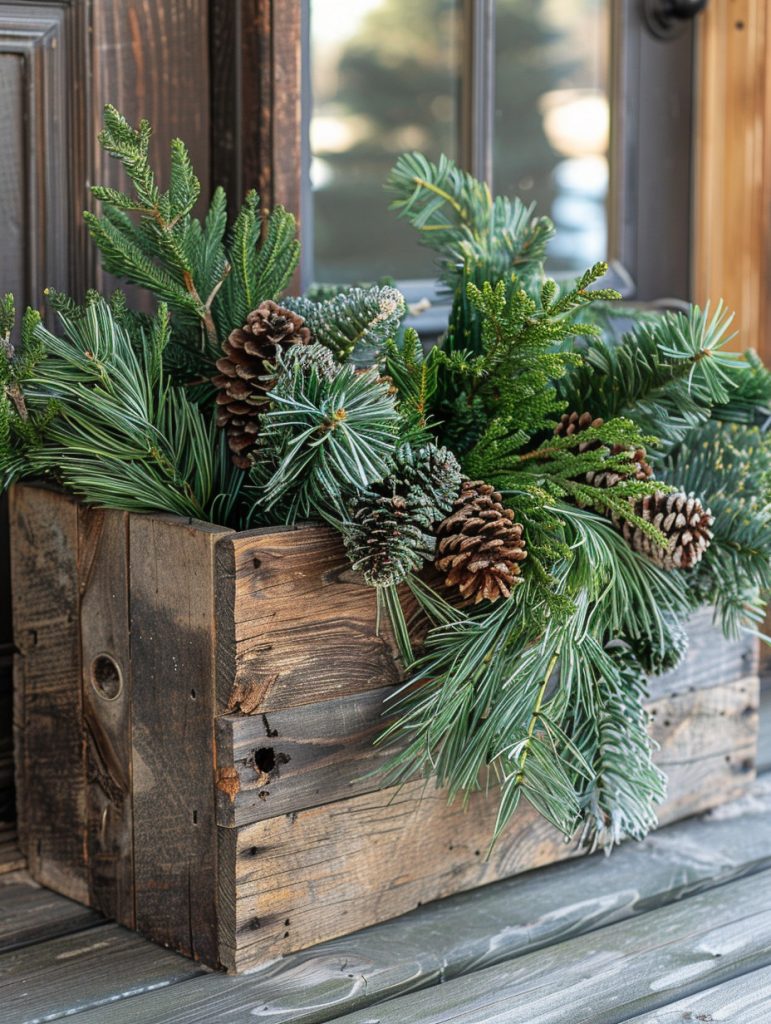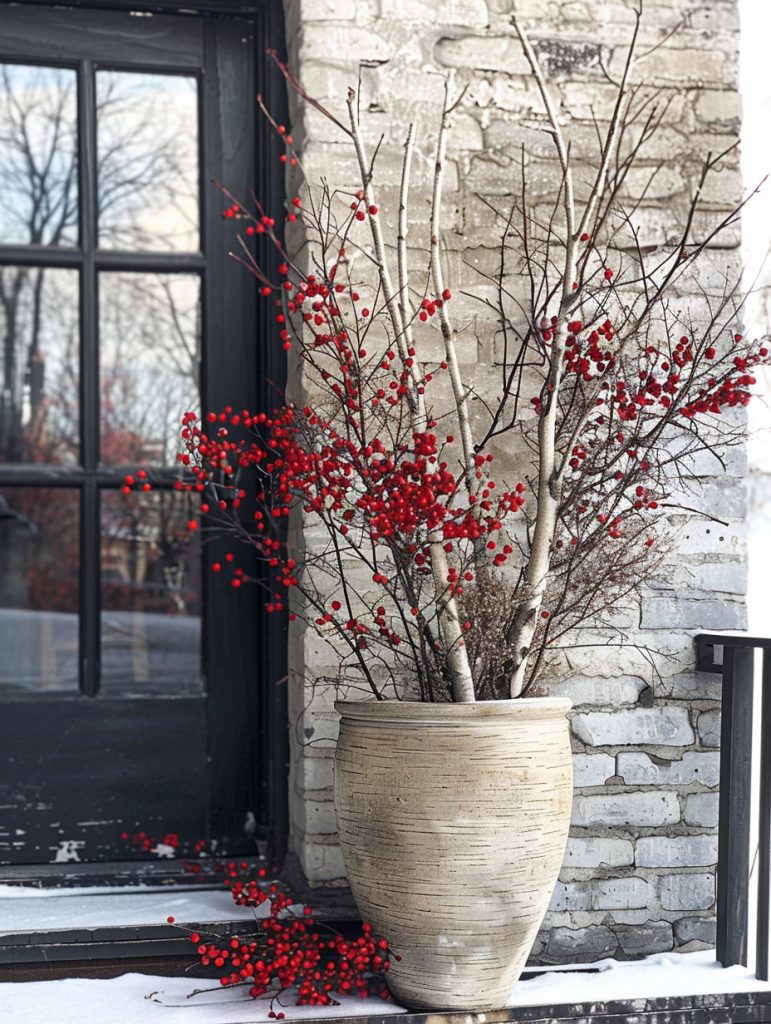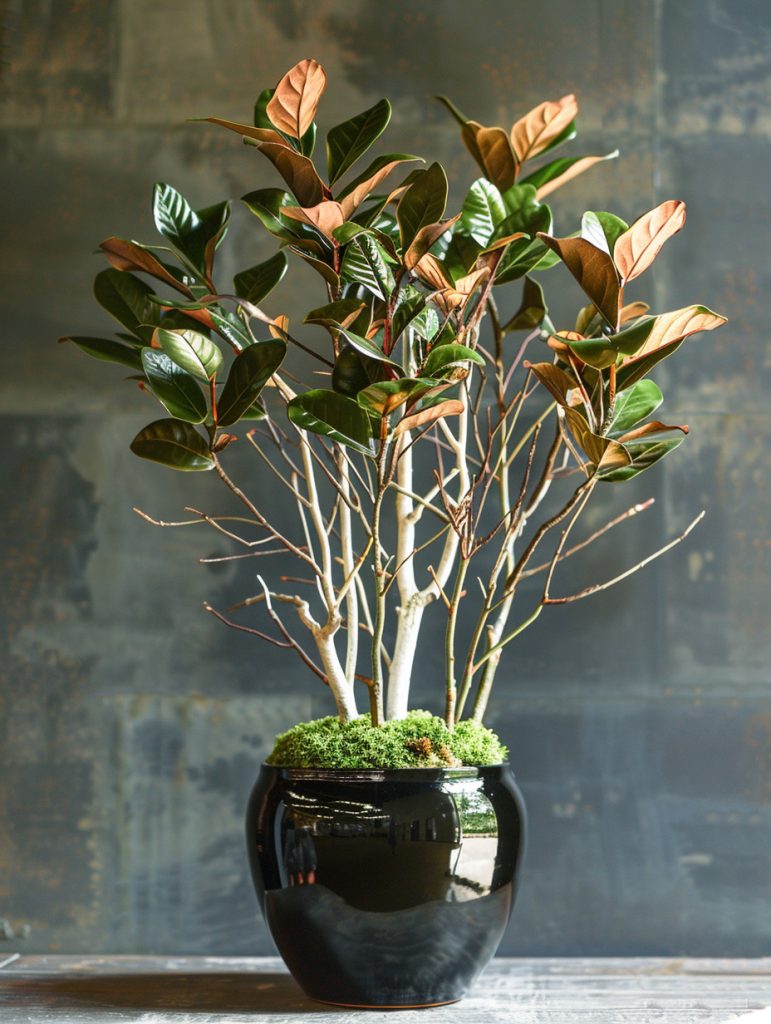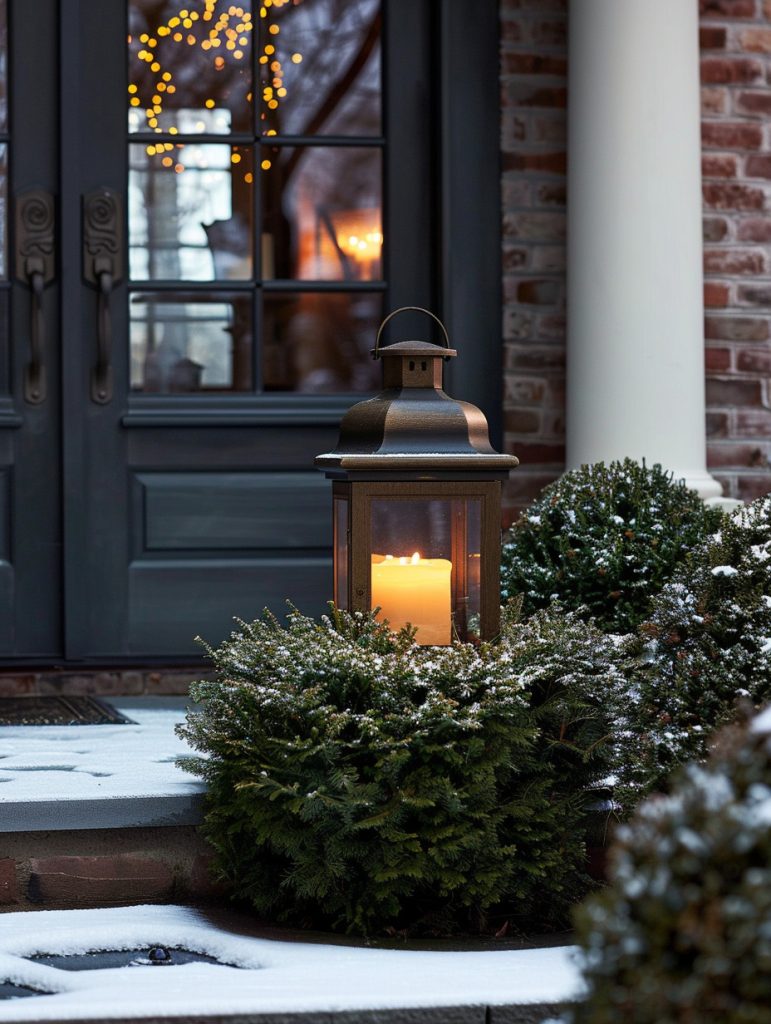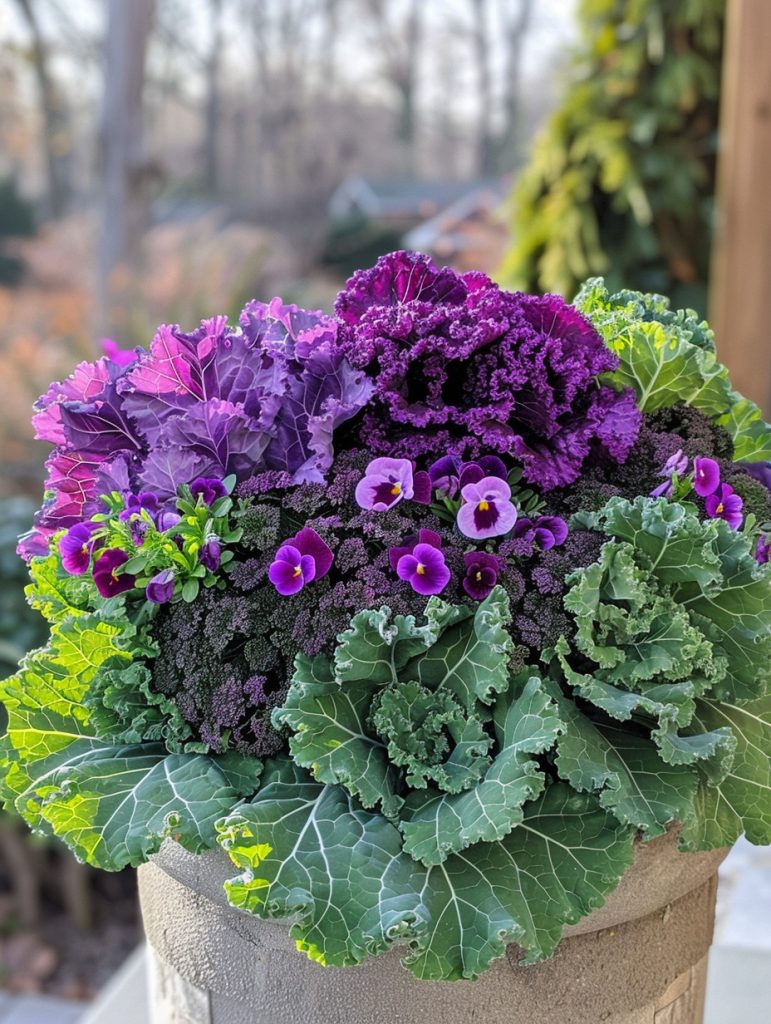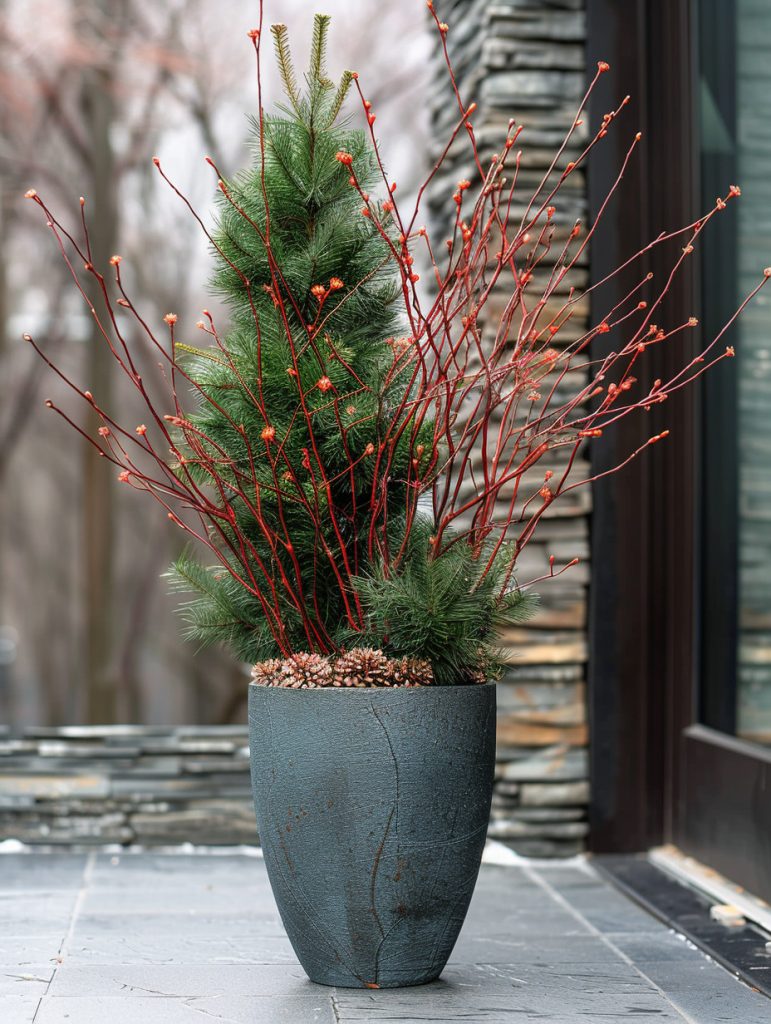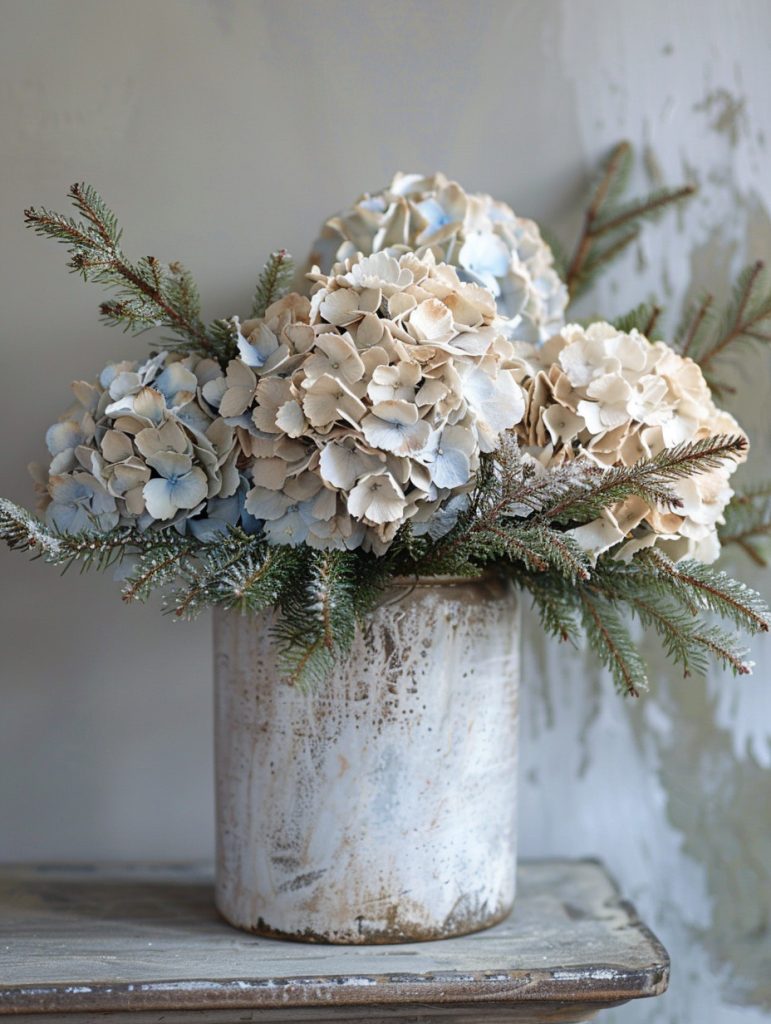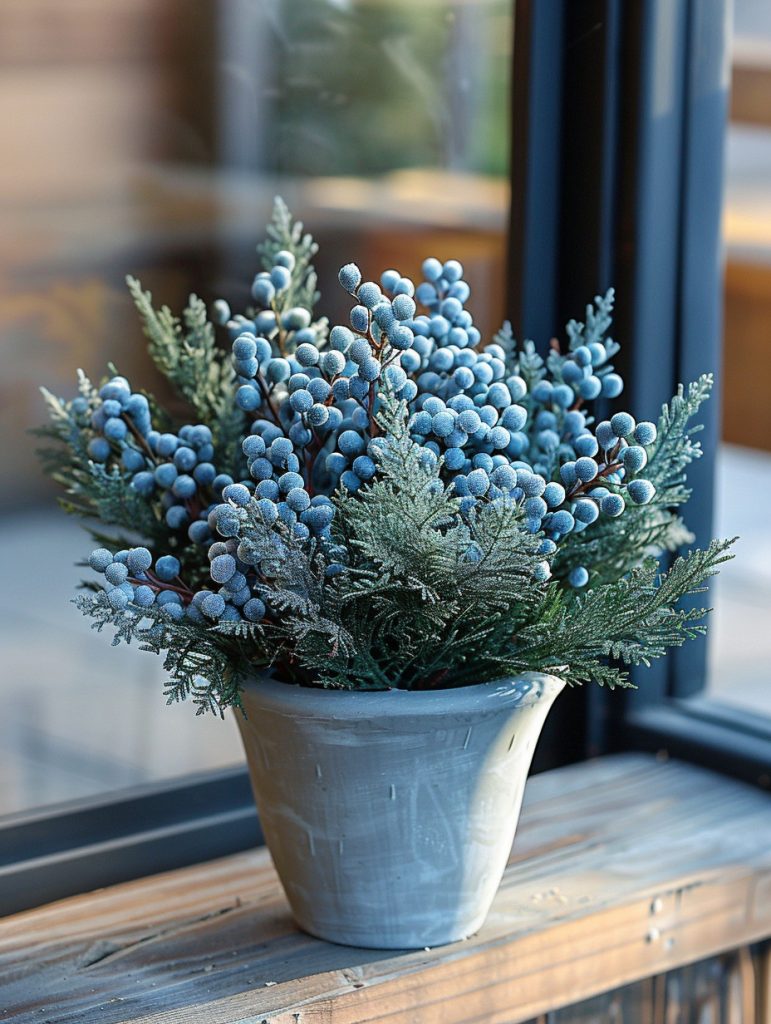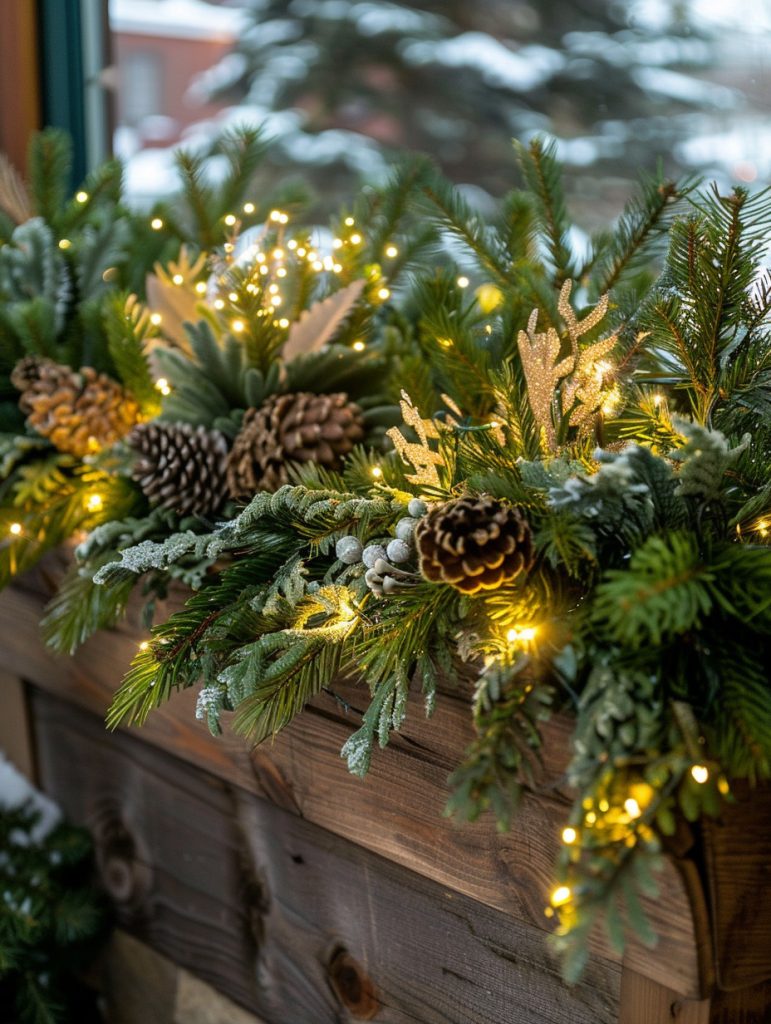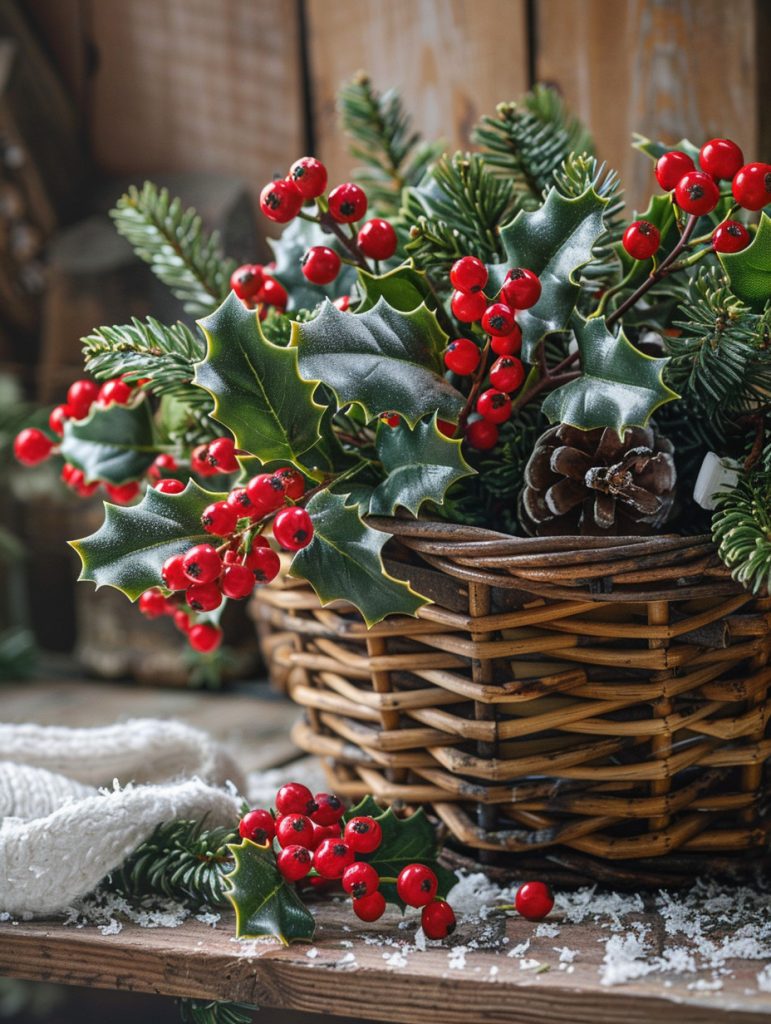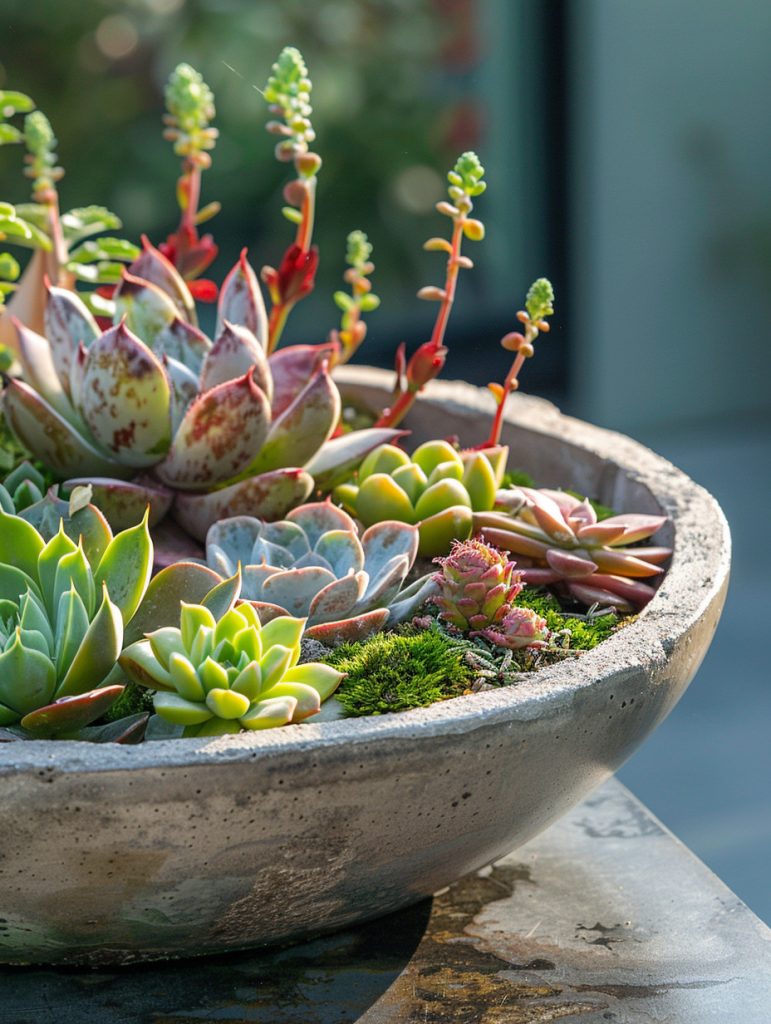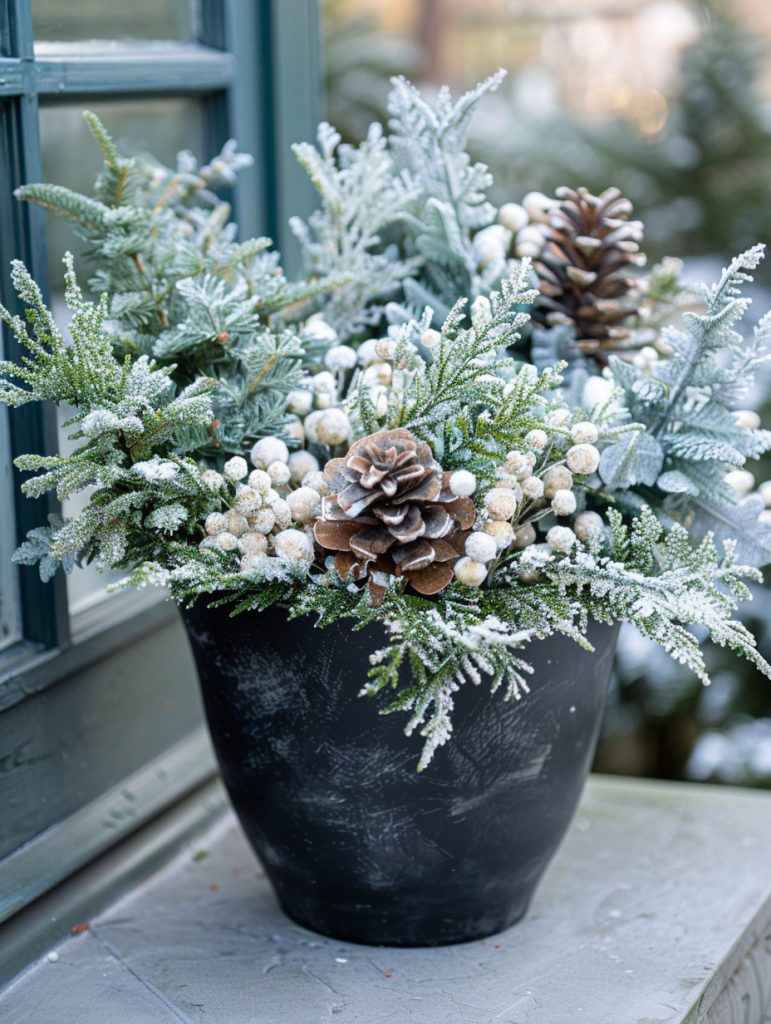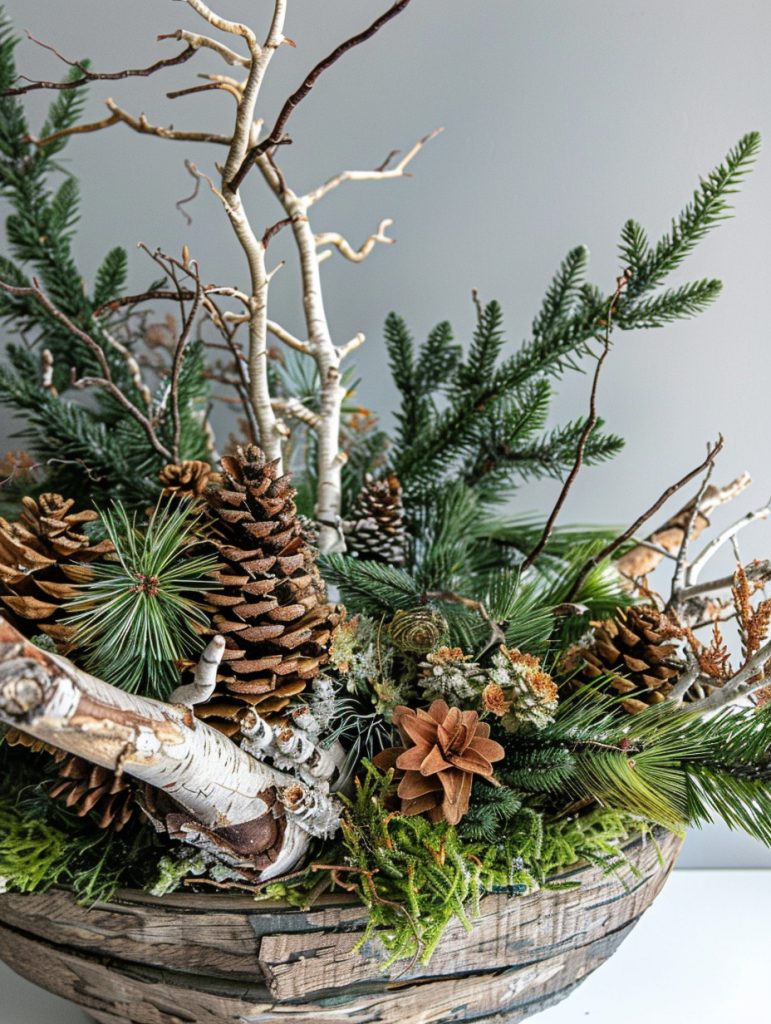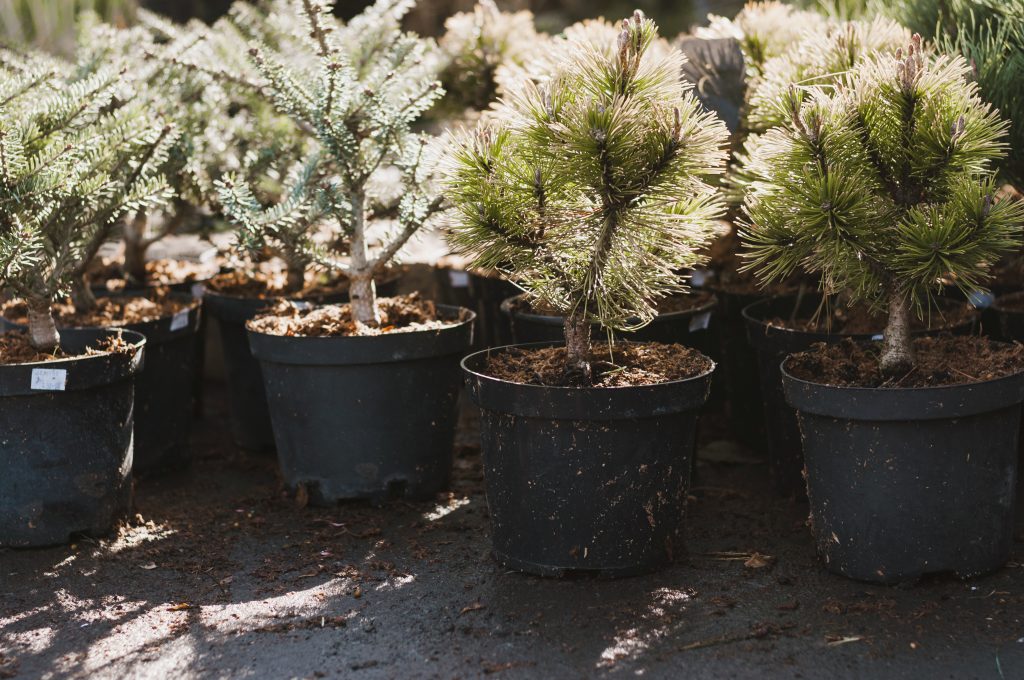Just because it’s cold out doesn’t mean your planters have to sit empty.
Winter’s actually a good time to pull together a few greens, some branches, maybe a few berries or lights, and create something that still looks alive and welcoming.
Most of the time, a few clippings from your yard or local market will do the trick.
Whether you’re aiming for cozy and rustic or neat and tidy, there’s a winter planter idea out there that’ll fit your style and your weather.
This list covers a bit of everything – classic evergreens, cold-hardy herbs, dried blooms, and even a few options with lights.
Let’s go through some ideas that are simple, good-looking, and hold up well in the cold.
Choosing the Right Planter for Winter
Before getting into what goes in the planter, it helps to make sure you’ve got the right kind of pot to start with.
Not every container can handle freezing temps, and the last thing you want is one that cracks halfway through the season.
Stick with weatherproof materials like resin, fiberglass, plastic, concrete, or metal. Terracotta can work in mild winters, but in freezing areas, it’s known to crack unless it’s labeled frost-resistant.
If you’re reusing a summer container, just make sure it’s not holding moisture that could freeze and expand.
Size matters too. Heavier pots are less likely to tip over in winter wind, especially if you’re using tall branches. Go for something with a wide base if your spot gets gusty.
If you’re planting live things (like kale, herbs, or hellebores), make sure the container has drainage holes.
And if it’s sitting on something like a wooden porch, put a saucer or plant feet underneath so moisture doesn’t collect and cause damage.
Lastly, if your winters are rough, you can line the inside of your pot with bubble wrap or landscape fabric to give the roots a little extra insulation – especially if you’re keeping plants in the soil instead of just arranging cut greens.
For more inspiration on how to make the most of your outdoor space in cold weather, check out my guide to best winter garden ideas.
Best Plants and Materials for Cold Weather Arrangements

Winter planters don’t need to rely on blooms to look good.
It’s all about texture, contrast, and using things that hold up when it’s cold and gray out. Here’s a breakdown of what actually works well (and lasts) through winter.
For more inspiration on seasonal planting, you can also check out my guide on the top plants to grow in winter.
Live Plants That Can Handle Cold
If you want something living in your planter, go for plants that don’t mind cold soil and chilly air:
- Ornamental Kale & Cabbage – These don’t just survive frost, they look even better with it. Great for adding shape and color.
- Violas & Pansies – In milder winters, these can still bloom. They’re small but add a nice soft touch.
- Hellebores (Christmas Roses) – These bloom in late winter and can handle freezing temps just fine.
- Ivy – Trailing ivy holds up well in the cold and softens the edges of pots.
- Rosemary & Thyme – In zones that don’t freeze hard, these herbs stay green and useful.
If you’d like to grow even more edibles through the colder months, take a look at my list of cold hardy vegetables that thrive in winter gardens.
Cut Greens That Stay Fresh
For decorative planters, cut branches from evergreens are your best bet. They’ll last weeks (sometimes months) in the cold:
- Cedar, Pine, Fir, Spruce – Layer them to add fullness and variety. Cedar drapes nicely, pine gives height, fir adds density.
- Juniper – Adds that nice silvery-blue tone and sometimes has berries.
- Boxwood – Keeps its shape and color, good for neater arrangements.
Branches, Berries & Extras
These are the little touches that make a planter stand out:
- Birch Logs or Branches – Pale bark and tall shape add structure.
- Red-Twig Dogwood – That bright red bark is striking against snow and greenery.
- Winterberry Holly (or Faux Berries) – Real ones are great, but faux stems work too and won’t rot.
- Dried Hydrangeas – If you saved any from fall, they hold up well and add a soft, full texture.
- Painted Twigs or Pinecones – White or silver paint gives a frosty touch.
- Moss – Tucks around the base and hides foam or soil.
Lights & Decorations
- Fairy Lights – Battery-powered outdoor lights can be tucked in easily and make a big difference when it gets dark early.
- Lanterns – A small lantern with a flameless candle adds warmth without real flames.
- Woven Baskets – If you want a change from ceramic pots, use a lined basket for a more rustic, cozy look.
15 Eye-Catching Winter Planters Ideas
If you’re not sure where to start, this list will give you a good mix of easy, good-looking setups that hold up well in winter.
Some are made with things you might already have around – like clippings from your yard, old summer planters, or baskets you can repurpose.
Others lean more decorative or seasonal. Whether you want rustic and natural or neat and tidy, you’ll probably find something here that fits your space and style.
1. Evergreen and Pinecone Mix
This setup is all about using what’s easy to find but still looks put-together.
A mix of cut pine, spruce, and cedar gives you variety in shape and color – cedar hangs softly, spruce adds density, and pine brings height with longer needles.
The pinecones break up all that green and give it a rough, rustic texture. You can wedge them right into the greenery or wire them onto small sticks to keep them in place.
If you have an old wooden crate or galvanized tub, this mix looks especially good with those – like something you’d see on a cabin porch.
It doesn’t need lights or ornaments to work, but you can always add a few if you want to dress it up later in the season.
2. Birch Branches with Red Berries
If you’re going for something bold but simple, this combo does the job.
Birch branches (either from your own tree or store-bought logs) stand tall and pale, adding instant height and a clean vertical line.
They look best in narrow or upright containers, where the height feels intentional, not top-heavy. Tuck in real or faux berry stems (like winterberry holly) around the base.
The red from the berries doesn’t just add color – it gives contrast that draws the eye, even from the street.
This one works great in pairs flanking a front door or along stairs where the height won’t be blocked.
3. Magnolia Leaves and White Twigs
This planter idea leans more polished than wild.
Magnolia leaves are thick, glossy, and hold their shape for weeks – especially if you give them a quick spray with an anti-desiccant to keep moisture in.
The green side adds depth while the brown underside brings in some warm tone.
For the white twigs, you can either paint real branches or buy pre-painted ones – just avoid anything too shiny or glittery if you’re going for a natural look.
This combo works best in a black or deep green ceramic pot where the leaves pop. Add a bit of moss at the base to hide the soil or foam and keep it clean-looking.
4. Boxwood and Lantern Planter
Boxwood is one of the few greens that keeps its shape and color all winter, even in freezing temps.
It’s dense, compact, and doesn’t shed like pine or cedar, which makes it perfect if you want something that looks tidy for weeks without much fuss.
For this setup, plant or pack in boxwood tightly so it forms a low, rounded mound. Then nestle a lantern right into the center or slightly off to one side.
A battery-operated candle with a timer is best – less hassle than dealing with real flames.
If you live where it gets dark early, that soft glow from the lantern adds a warm, welcoming look that makes the whole planter feel lived-in, not just decorative.
5. Ornamental Kale with Violas
This one’s more about color than structure, but it holds up surprisingly well in the cold. Ornamental kale and cabbage stay vibrant after frost, and their ruffled leaves bring a lot of texture.
Stick to purple, green, or white varieties – they look good mixed together or with just one bold type.
Around the edges, plant violas. They’re small but will keep blooming into winter in zones that don’t freeze solid. Use a wide, shallow pot so everything sits close together and can be seen from above.
Water just enough to keep the soil barely moist – too much and you’ll get rot when the temps drop.
6. Rosemary and Thyme Winter Herb Pot
If you live in a zone where winters are mild (or if you keep your pots tucked in a protected spot), rosemary and thyme will stay green and usable through the season.
Choose a rough clay or metal pot for that rustic look.
You can plant them straight into the soil if you’re keeping it year-round, or just tuck nursery pots in and cover the base with moss or bark to hide them.
What makes this planter stand out isn’t just that it looks good – it smells great and you can actually use the herbs.
Snip off rosemary sprigs for roasting or thyme for soups without having to run to the store. Just make sure it gets a bit of sun and isn’t soaked.
If you want to keep your rosemary thriving long-term, you can follow my simple guide on how to prune rosemary.
7. Red Dogwood Branches and Evergreens
This one’s all about contrast. Red-twig dogwood has deep red bark that stays bright through winter, especially after a good frost.
When you stick those stems into a backdrop of dark green pine or fir, the color really pops. It’s a good fit for a modern farmhouse look – bold and clean without being fussy.
Use a tall, narrow container if you want to show off the vertical lines, or go with a wider one if you’re adding multiple dogwood stems with mixed greens underneath.
To keep it balanced, use evergreens with shorter needles so they don’t compete with the dogwood. No need for lights or extras – this one makes a strong statement on its own.
8. Hellebores and Ivy Planter
Hellebores (sometimes called Christmas roses) start blooming in late winter, even when there’s still snow on the ground.
The flowers come in soft colors like cream, pink, or deep plum, and the leaves stay green year-round.
Pair them with trailing ivy in a shallow, wide pot where they can spread a bit without looking cramped. This planter works best in a spot that gets some shelter, like under a porch roof or against a house wall.
If you want it to last past winter, go for a pot that can handle freezing without cracking, since both plants can be left in place well into spring.
Water lightly every so often, just enough to keep the soil from drying out.
9. Dried Hydrangeas with Spruce Tips
If you saved hydrangea heads from summer or early fall, they still have a lot to offer.
Dried, they hold their shape and a faded version of their color – soft blue, dusty pink, or beige depending on the variety.
Spruce tips give a solid evergreen base that holds everything in place. This combo leans more textured than colorful, so it’s perfect if you want something subtle.
Place the hydrangeas higher in the arrangement so they don’t get crushed by the spruce.
If you want to add a bit of shine, you can mist the dried flowers lightly with a matte gold or silver spray – just enough to catch light, not to make them flashy. Works great in a cement or metal planter.
10. Juniper with Blue Berries
Juniper doesn’t get as much attention as other evergreens, but it’s one of the best for winter planters – especially the varieties with soft blue berries.
The needles have a bluish tint too, which gives this arrangement a cool, muted tone that works especially well in modern or minimalist setups.
Use several juniper branches packed tightly for fullness, or mix them with something like dusty miller if you want even more silver tones.
This is a great choice for anyone who wants low effort – juniper holds up in cold weather and doesn’t drop needles easily.
Best in smaller pots or window boxes where the finer texture can be seen up close.
11. Twinkle Lights and Mixed Greens
This one is perfect for places where you want a little glow – like near an entryway, along steps, or tucked beside a bench. Start by layering a mix of cedar, pine, and fir.
Cedar drapes over the sides, pine gives height, and fir fills in the gaps.
Once the greenery is in place, weave in a short strand of battery-operated fairy lights, ideally the kind with a timer so you don’t have to mess with them daily.
Avoid anything too bright or colored – warm white lights work best here. Make sure the battery pack is tucked in where it’s protected from rain or snow.
The result is simple but has a lot of impact once the sun goes down.
12. Rustic Basket with Holly
Swapping out a regular pot for a basket adds a lot of charm with very little effort. Just make sure it’s lined with plastic or a grow bag so moisture doesn’t seep out and damage the basket.
Fill it with fresh-cut holly branches – the kind with deep green leaves and bright red berries. You can add a bit of pine or cedar around the edges, but the holly is the main feature here.
This combo works really well as a tabletop or step-side piece and gives off that classic holiday look without going overboard.
Since holly can dry out faster than other greens, place this one in a shaded spot and mist it once in a while if the weather’s dry.
13. Succulent and Moss Winter Bowl
This one works best in areas with mild winters, or in a sheltered spot like a covered porch.
Cold-hardy succulents (like hens-and-chicks (sempervivum) or stonecrop (sedum) can handle light frost, especially if they stay dry.
Arrange them in a shallow ceramic or concrete bowl with plenty of drainage. Around the base, tuck in green moss (live or preserved) to fill gaps and soften the look.
The moss also helps protect the roots a bit and keeps the arrangement from looking bare.
This setup is low-maintenance and brings a clean, almost sculptural look that holds up through winter and can easily be freshened up in spring.
14. Silver Accents with Dusty Miller
Dusty miller has soft, silvery leaves that don’t mind the cold too much and pair well with most evergreens. It brings a “frosted” look without needing snow.
You can plant it in soil if you want it to last, or just use cut stems tucked into a base of pine or fir branches.
Add in a few white-painted pinecones or light-colored seed pods to keep the pale tones going. This one looks especially nice in darker pots (like charcoal or navy) to make the silver stand out more.
It works well on its own or as a calm, cooler-toned contrast to bolder, red-heavy decorations nearby.
15. Mixed Forest-Inspired Planter
If you want something that looks like it was gathered straight from a walk in the woods, this one’s for you.
Start with a mix of cedar, pine, and fir for the base, then add in branches—some smooth, some knobby – and a few big pinecones.
You can also tuck in bits of moss, bark, or lichen-covered twigs if you have them. There’s no symmetry or “right” way to arrange this – just layer it like nature would.
It works best in wide, heavy containers where you can let it sprawl a bit. No lights or bright accents – just natural, textured materials that feel like a little patch of forest on your doorstep.
How to Arrange a Winter Planter
You don’t need to be a designer to put together a good-looking winter planter.
It mostly comes down to layering things the right way so it feels full and balanced. Whether you’re using live plants, cut greens, or a mix of both, here’s how to pull it together.
Start with a Solid Base
If you’re planting live things like kale or hellebores, use potting soil. For cut greens or branches, you can skip the soil and use:
- Sand or moist potting mix to help anchor stems (if you’re curious about what to fill your containers with year-round, I’ve shared my guide on the best potting soil mix for healthy plants.)
- Floral foam if you want to be precise with placement.
- Just make sure everything’s packed in tightly enough that it won’t shift when the wind hits.
Use the “Thriller, Filler, Spiller” Approach
This simple method helps with balance and visual interest:
- Thriller – This is your tall, eye-catching piece. Birch branches, dogwood stems, or a lantern work well here.
- Filler – These fill out the middle. Think evergreens, boxwood, kale, or rosemary.
- Spiller – These drape over the edge and soften the look. Ivy, trailing cedar, or moss are good for this.
You don’t have to follow this to the letter, but it’s a good starting point.
Mix Textures and Tones
Layering different types of greens gives more depth:
- Mix flat, glossy leaves (like magnolia or boxwood) with needle-like branches (pine, fir).
- Add contrast with silvery plants (like dusty miller) or blue-toned juniper.
A few red berries, pinecones, or dried blooms keep it from looking flat.
Balance the Height
Put taller pieces toward the back if your planter is against a wall or near a door. If it’ll be seen from all sides, keep the tall items centered and work your way out with shorter elements.
For more inspiration on arranging outdoor spaces, check out my guide to an easy homestead garden layout.
Tuck Everything in Firmly
Push stems down far enough so they don’t blow away. You can also use floral wire or zip ties to keep bunches of greenery together before placing them in the pot.
How to Keep Winter Planters Looking Fresh
Winter planters don’t need much upkeep, but a few small habits can make a big difference in how long they look good.
The cold actually helps preserve most materials – but wind, sun, and moisture are what usually wear them down.
1. Keep Them Out of Harsh Wind (If You Can)
Strong wind can dry out greens, snap branches, and scatter loose parts like pinecones or moss.
If possible, place your planters near a wall, porch, or corner where they’re a little more protected. Even just moving them off the edge of an open patio can help.
For another way to shield plants from winter stress, you might like my comprehensive cold-frame gardening guide.
2. Don’t Overwater
If you’re using live plants (like kale, rosemary, or hellebores), they’ll need a little water now and then – just not much.
In cold weather, soil dries out slowly, and overwatering can freeze the roots or lead to rot. Stick your finger in the soil: if it’s slightly damp, it’s fine.
For arrangements made with cut greens, no watering is needed at all.
If you’d like tips for your houseplants during the colder months, you can check out my article on how to water plants indoors.
3. Mist Greens Occasionally
If the air is dry and your evergreens are starting to brown, a light misting with water every week or so can help keep the needles from drying out too fast.
Do this in the morning on milder days so it has time to evaporate before temperatures drop again.
4. Swap Out Pieces That Fade
Some parts of your arrangement may start to fade before others – especially berries, ivy, or more delicate greens. You don’t need to redo the whole thing.
Just pull out the pieces that look tired and replace them with fresh cuts, faux stems, or even a few winter ornaments to stretch the life of the planter.
5. Transition to Early Spring
Once late winter hits and things start thawing, you can start freshening up your planters by adding early bulbs (like snowdrops or crocus) or swapping in pansies and fresh ivy.
If you used a basket or foam insert, the transition is quick – just lift out the winter material and pop in the new.
And if you’re already thinking ahead to spring, check out my favorite rose garden ideas for blooms that will wow your garden.
Bring Life to Your Porch This Winter – One Planter at a Time
Winter doesn’t have to mean bare pots and dull entryways.
With a few cuttings, some cold-hardy plants, or even things you already have at home, you can pull together a planter that looks good all season long.
Whether you’re into the simple mix of pine and pinecones, or something more styled like magnolia with white twigs, the ideas in this list are easy to adapt to your space, your climate, and your style.
The best part? Most of these don’t take much time or money – just a bit of creativity and what’s available around you.
Try one of these ideas this winter and let us know how it turned out – drop your favorite combo or tips down in the comments.
FAQs
1. Can I use fresh-cut Christmas tree branches in my winter planter?
Yes, absolutely. Leftover tree trimmings are perfect for planters – especially fir, pine, or spruce. Just trim the ends and stick them in tightly. They'll hold up for weeks in the cold.
2. What’s the easiest winter planter idea for total beginners?
A simple bundle of cedar, pinecones, and a few birch sticks in a bucket or pot is about as easy as it gets – and still looks great. No planting or fancy materials needed.
3. Will critters bother my winter planter?
Sometimes. Squirrels and birds may check out pinecones or berries, especially if they’re real. Using faux berries or misting the arrangement with a natural deterrent (like diluted peppermint oil) can help.
4. Can I build a winter planter with things from the grocery store?
Yes. Herbs like rosemary, thyme, or sage can often be found potted in the produce section. Combine those with a few cut greens from a florist or tree lot, and you’re good to go.
5. How do I store decorations like birch logs or faux berries after winter?
Let everything dry fully before packing. Store in a cool, dry place in a cardboard box or bin with ventilation to avoid mold. Faux items like berries or painted twigs can be reused for years.
Ready To Transform Your Garden?
Are you looking for the best way to layout your garden beds? Maybe you're feeling a bit stuck on how to make the most of your space?
We’ve got you covered! Check out our 101+ Garden Bed Layout Ideas for your next raised bed project. This guide is filled with creative and practical ideas that can help you design a garden that fits your style, whether you’re just starting out or have been gardening for years.
Get your copy today and get inspired to bring your gardening dreams to life.

